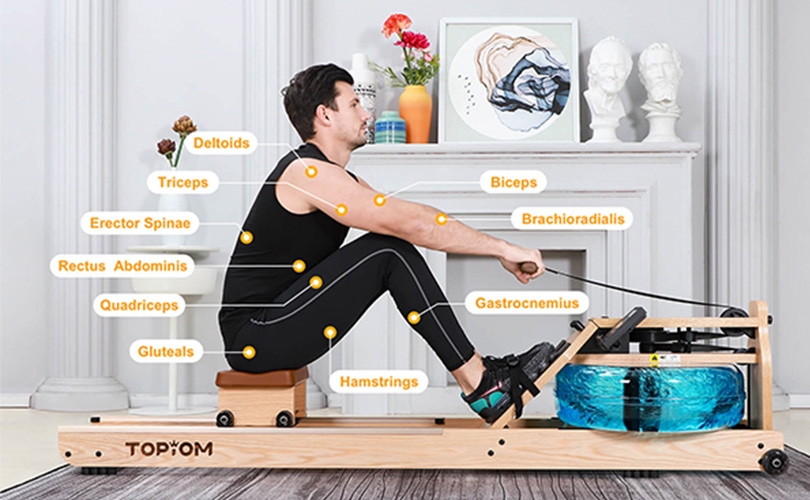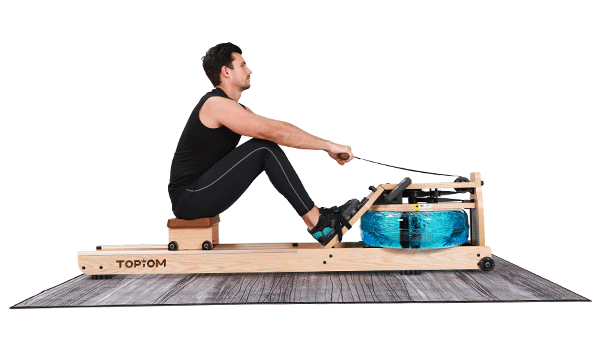Wanna boost your all-round fitness? Wanna give the muscles you do not use in cycling a chance to work out? Choose rowing for cyclists to go farther, faster, and more efficiently in 2021.
 Cross-training with rowing can play an important role in the overall fitness routine of a cyclist. It gives you a total body workout and helps prevent burnout to keep you biking nonstop, injury-free.
Cross-training with rowing can play an important role in the overall fitness routine of a cyclist. It gives you a total body workout and helps prevent burnout to keep you biking nonstop, injury-free.
Table of Contents

 A 2014 study of 24 people over 8 weeks found that joint torques, or rotations, in the elbow, shoulder, lumbar, and knee improved by 30 percent. Rowing is a perfect cross-training for cyclists with joint issues to get a break from cycling while conditioning the whole body.
A 2014 study of 24 people over 8 weeks found that joint torques, or rotations, in the elbow, shoulder, lumbar, and knee improved by 30 percent. Rowing is a perfect cross-training for cyclists with joint issues to get a break from cycling while conditioning the whole body.
 For a more comprehensive guide, check out our blog post: indoor rowing techniques for rowing beginners. A complete step-by-step guide including rowing form, breathing, power exertion, and stroke timing is provided. Additionally, watch your form and stay aware of the common rowing machine mistakes and the potential for injuries, such as back pain, butt pain, and knee pain. It will help you get started and achieve the desired results without risking injury.
For a more comprehensive guide, check out our blog post: indoor rowing techniques for rowing beginners. A complete step-by-step guide including rowing form, breathing, power exertion, and stroke timing is provided. Additionally, watch your form and stay aware of the common rowing machine mistakes and the potential for injuries, such as back pain, butt pain, and knee pain. It will help you get started and achieve the desired results without risking injury.

 Cross-training with rowing can play an important role in the overall fitness routine of a cyclist. It gives you a total body workout and helps prevent burnout to keep you biking nonstop, injury-free.
Cross-training with rowing can play an important role in the overall fitness routine of a cyclist. It gives you a total body workout and helps prevent burnout to keep you biking nonstop, injury-free.
Table of Contents
- Benefits of Rowing for Cyclists
- How to Reap the Benefits of Rowing for Cyclists?
- Important Note
- Final Thought
Benefits of Rowing for Cyclists
There seems to be an endless list of benefits of rowing. But are you aware of the benefits of rowing for cyclists specifically? Rowing offers a great aerobic (or anaerobic) alternative to cycling with most of the fitness gains transferring easily.“Cross-training is important to prevent injury and strengthen the muscles you don’t use on the bike, …… Your anterior body (like your chest) is hunched forward on a bike, and rowing opens these muscles up while strengthening the posterior side of the body (like your back and the back of your legs).” — Alex Silver-Fagan ACE-certified personal trainer and Nike master trainer
Rowing for Cyclists: The Ultimate Full-Body Cross-Training
Instead of just providing a lower body workout, rowing is the ultimate full-body cross-training for cyclists. In a study from the English Institute of Sport, researchers found that the rowing machine engages 86 percent of the muscles in your body.“Rowing is a low-impact form of training that utilizes all major muscle groups, including your legs, core, back, and arms.” — Hollis Tuttle Certified coach and director of instructors at CityRow in New York City.Aside from toning your legs, rowing works all the major muscles in your body if done correctly. It targets the glutes, hamstrings, quads, core, back, shoulders, and arms. That’s a perfect complement for cyclists.

Rowing for Cyclists: The Perfect Knee-Friendly Cross-Training
Not everyone is prepared to cycle anytime. But everyone does want to keep fit and be prepared for the next road cycling, road cycling, mountain biking, track racing or BMX. If you are one of the cyclists who are not in the state of cycling, diversify your training routine by adding rowing. In contrast to cycling, rowing is low impact and easy on your knee joints. Rowing is a smooth, rhythmic motion that is much safer for giving you a good full-body workout. Moreover, regular rowing strengthens your joints and increases mobility without causing more damage. It helps boost your cardio fitness, avoid re-injury and increased knee pain. This is all thanks to the position of the body. The entire workout is done seated. When you row properly and maintain a relaxed body posture, you are at the lowest risk of feeling a negative impact. A 2014 study of 24 people over 8 weeks found that joint torques, or rotations, in the elbow, shoulder, lumbar, and knee improved by 30 percent. Rowing is a perfect cross-training for cyclists with joint issues to get a break from cycling while conditioning the whole body.
A 2014 study of 24 people over 8 weeks found that joint torques, or rotations, in the elbow, shoulder, lumbar, and knee improved by 30 percent. Rowing is a perfect cross-training for cyclists with joint issues to get a break from cycling while conditioning the whole body.
Rowing for Cyclists: The Ideal Active Recovery
As a non-weight-bearing exercise, rowing burns serious calories without putting added stress on your joints. It allows you to control the movement and pace, making it an ideal exercise to turn to for active recovery. This exercise is recommended for rehabilitation after joint surgeries like endoprosthesis of the hip as the safest and most efficient. In addition, it’s sometimes recommended as an exercise option for people with early stages of osteoarthritis or arthritis to stay in shape. It’s also good for you if you’re recovering from an injury or battling with other aches and pains. Rowing is the best active recovery for injury rehab. When you row properly and maintain a relaxed body posture, you are at the lowest risk of feeling a negative impact. Rowing is a godsend for the most fragile at the knees, hips, ankles, or shoulders. If you are looking for a low-impact yet all-round sport, the rowing machine is for you!How to Reap the Benefits of Rowing for Cyclists?
Now that we’ve been aware of the benefits of rowing, are you keen on reaping the benefits? Let’s hop on a rowing machine and start the impact-free cross-training to become a stronger, healthier, and happier runner in 2021! To get started rowing indoors, check out this video by Josh Crosby, an Ironman competitor, and world champion rower.Rowing Terms and Metrics
Like cycling and biking, rowing utilizes a unique set of terminology. If you have never rowed before, don’t worry! Let’s start from the basics and get familiar with the rowing terms and metrics.Ergometer
Ergo for short and refers to an indoor rower. The name comes from the early indoor machine used by rowing clubs to measure the performance and technique of their rowers to find the best combination for the positions in a boat.Stroke
One full rowing action comprising of four phases: Catch – set-up for the next phase. Drive – generates the power Finish – also known as the Release is the end of the stroke Recovery – slide back to the catch positionStroke rate
Stroke rate is a rowing metric to indicate your cadence or pace, reflecting how many times you row (stroke) on the rower in 1 minute. The metric is measured in “strokes per minute” (“s/m” or “spm”).Split time
Split time normally refers to the time it takes you to row 500 meters. It shows your speed and is a reflection of the amount of force you apply to each stroke. A 2:00 split time means that it takes you two minutes to complete 500 meters.Wattage / Watts
The amount of energy you’re producing with each stroke. The higher the number, the harder you’re working. Above is a short list of the most common terms and metrics used throughout the sport of indoor rowing. Learn more about rowing machine terminology here. Additionally, mastering two important rowing metrics (stroke rate & split time) is essential to your success in rowing, helping you reap the benefits for cycling faster.Rowing for Cyclists: Quick Guide to Correct Indoor Rowing Technique
To get started rowing indoors, Master the correct technique is always important to help you achieve your fitness goal without risking injury. The key to rowing is to understand the motion and the different positions you’re in when rowing. A full “stroke” of rowing can be broken down into four distinct phases from beginning to end – the catch, drive, finish and recovery. Check below a quick beginner’s guide to correct rowing technique. For a more comprehensive guide, check out our blog post: indoor rowing techniques for rowing beginners. A complete step-by-step guide including rowing form, breathing, power exertion, and stroke timing is provided. Additionally, watch your form and stay aware of the common rowing machine mistakes and the potential for injuries, such as back pain, butt pain, and knee pain. It will help you get started and achieve the desired results without risking injury.
For a more comprehensive guide, check out our blog post: indoor rowing techniques for rowing beginners. A complete step-by-step guide including rowing form, breathing, power exertion, and stroke timing is provided. Additionally, watch your form and stay aware of the common rowing machine mistakes and the potential for injuries, such as back pain, butt pain, and knee pain. It will help you get started and achieve the desired results without risking injury.
Rowing for Cyclists: Sample Cross-Training Workouts
For cyclists, rowing might be the next best thing. You’ll improve your power by building strength in the legs and core while also taxing the cardiovascular system. If you train on a bike, this should sound familiar. No matter how many years go by, cycling faster, farther, and more efficiently are the goals most cyclists aspire to achieve. In order to reach the desired goals, you’ll need to improve your speed, strength, and endurance. Try out the following rowing workouts to up your cycling game and ride faster, farther, and more efficiently in 2021.Rowing Workout for Speed
Sprints are sprints, whether you’re on a bike or a rower. This is a typical pyramid sprint interval workout. Do each sprint effort should be at a stroke rate of 28 to 32, if possible. Try to keep your split times at each interval around 1:50 or lower. finish each sprint effort in the same amount of time.- 100m row followed by 30 seconds of rest X 5
- 150m row followed by 45 seconds of rest X 5
- 200m row followed by 60 seconds of rest X 5
- 2 minutes of rest
- 200m row followed by 60 seconds of rest X 5
- 150m row followed by 45 seconds of rest X 5
- 100m row followed by 30 seconds of rest X 5
Rowing Workout for Endurance
Your work effort should be at a stroke rate of 25 to 28, pushing hard but not crazy fast. Your split time should be around 2 minutes or lower towards the end of each push.- 1-minute row followed by 30-second rest: Hold drive position (a.k.a. seat at back of machine with legs straight) and do arm strokes while resting
- 2-minute row followed by 60-second rest (30 seconds true rest; 30 seconds holding drive position at back of machine doing arm strokes while resting)
- 3-minute row followed by 90-second rest (30 seconds true rest; 30 seconds holding drive position at back of machine doing arm strokes while resting; 30 seconds of just leg strokes: arms stay straight, straighten and bend legs)
- 4-minute row followed by 2-minute rest (60 seconds true rest; 30 seconds holding drive position at back of machine doing arm strokes while resting; 30 seconds of just leg strokes: arms stay straight, straighten and bend legs)
- 5-minute row
Rowing Workout for Strength
The rowing machine could be a tool within a larger workout. This is a full-body cross-training workout in which rowing is not highlighted. However, it still challenges your whole body and works your core, legs, and arms. In addition, it has less risk of getting bored and tired whilst giving you even more muscle-building opportunities.- 5-minute easy row warm-up
- 10 pulls followed by 5 push-ups and 5 V-ups X 2
- 20 pulls followed by 10 reverse lunges and 10 squat jumps X 2
- 30 pulls followed by 10 burpees X 2
- 30-second row followed by 30-second plank hold off the rower X 5
- Cool down
Rowing for Cyclists: Selected Training Resources
Keen to give the rowing machine a go? We have selected a list of quality yet free training resources to get you started, from correct rowing technique to example workouts, videos and drills. Whether you are an auditory, visual, or reading learner, there is something to help you reap the benefits of rowing. Check out our post: best free online resources for rowing machine workout. Who knows, you might be a natural. If you’d like to program a rowing workout by yourself, you may take some inspiration from our blog post: the ultimate guide to rowing machine workouts.Important Note
Always consult your physician or doctor before beginning any new exercise regimen. Since only your doctor or physician can determine whether it is right for your needs. Knowing whether you are medically able to participate and how much exercise is safe for you is essential to prevent you from damages or injuries.


